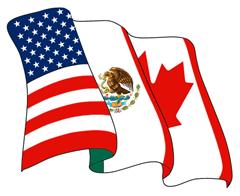NAFTA Overview
NAFTA Text
NAFTA & Agriculture
NAFTA & Women
NAFTA & Democracy
NAFTA’s Track Record
NAFTA & Labor
NAFTA & The Environment
NAFTA & Mexican Economy

NAFTA 15 Years Later
NAFTA Trade Ministers Agree To Examine Regulatory Differences October 19th, 2009
What the Three Amigos Should Have Talked About August 27, 2009
North American Labor Federations Blast NAFTA August 26, 2009
What Happened in Guadalajara August 24, 2009
NAFTA Is Our Real Problem August 20, 2009
NAFTA Has Failed August 14, 2009
Cracks Emerging in NAFTA August 12, 2009
Renegociate NAFTA as You Promised July 27, 2009
NAFTA The Unfulfilled Promise March, 23 2009
Letter to the President from Legislators to Renegociate NAFTA June, 18 2009
Mexico Challenges Calls To Buy American June, 29 2009
NAFTA Trade Down 33 Percent in April July, 01 2009
For a fair way forward . . .
NAFTA Overview
The United States, Canada and Mexico entered into the North American Free Trade Agreement (NAFTA) on January 1, 1994. The agreement eliminates tariff and non-tariff barriers to trade and investment over the course of fifteen years. NAFTA was approved under the “fast track” procedure which restricts Congress’ involvement in trade policy to an up or down vote on final legislation. During its contentious debate, NAFTA was touted as a measure which would among other things, raise living standards in all countries, increase democracy in Mexico, and create 200,000 U.S. jobs per year.
Ten years after its passage, a look at the effects of NAFTA across all three countries illustrates an overwhelmingly negative picture. The trade surplus the U.S. enjoyed with Mexico before NAFTA has since become a huge trade deficit, totaling $34.5 billion in 2002 alone; U.S. workers have lost 3 million actual and potential jobs; labor and environmental conditions have deteriorated in Mexico; and corporations and investors have perilously challenged safety regulations in all three countries. What’s more, family farms in both Mexico and the U.S. have suffered under NAFTA: the U.S. farm trade has fallen 57% in real terms and farm incomes have plummeted; Mexican farmers have also watched prices fall, and have called for a suspension of NAFTA tariff reductions, and a re-negotiation of NAFTA’s agriculture provisions.
Such social and environmental crises can be attributed, in great part, to the absolute lack of meaningful citizen involvement in the negotiating process, and to the way in which labor and environmental concerns were relegated to unenforceable “side agreements,” excluded from the core text of NAFTA legislation. (See “issues”)
Perhaps the most harmful aspect of NAFTA is that it set a dangerous precedent for future trade negotiations with the creation of a new mechanism to empower private investors and corporations to sue governments over public interest policies or actions they believe threaten their bottom line. These special investor rights are detailed in NAFTA’s Chapter 11 investment provisions. Under Chapter 11, foreign investors from Canada, Mexico and the United States can sue a national government if their company’s property assets, including the intangible property of expected profits, are damaged by laws or regulations of virtually any kind. These corporate lawsuits are arbitrated in a closed, undemocratic three-judge arbitration tribunal created by NAFTA. Many high profile, controversial cases have already been heard by the tribunal, awarding millions of taxpayer dollars in “damages” to corporate interests. This tribunal system, operating outside of the U.S. legal system and without public input, raises serious concerns about public openness and NAFTA’s threat to the principals of democratic process. In addition, rulings against basic public interests and state governments have created new fear that governments may now have to “pay to regulate” (go to “Investor Rights”).
Currently, the Bush administration is negotiating an expansion of NAFTA, through the Free Trade Area of the Americas (FTAA) which would include an additional 31 countries in the Western Hemisphere.
Seven Years of NAFTA: Myth and Reality Citizens Trade Campaign
Ten years of NAFTA in the San Diego/Tijuana Border Region Environmental Health Coalition, October 18, 2004
The Impact of NAFTA on the U.S. Latino Community and Lessons for Future Trade Agreements Labor Council for Latin American Advancement & Public Citizen, August 16, 2004




